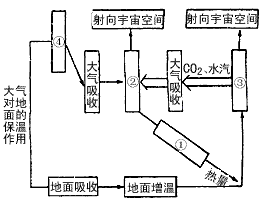下面是大气对地面的保温作用示意图,据图回答1—2题。

1、图中太阳辐射、地面辐射、大气辐射、大气逆辐射的数码代号按顺序依次是[ ]
A、①②③④
B、③④②①
C、④③②①
D、②③④①
2、青藏高原比长江中下游平原气温日较差较大的原因是:①离太阳近、②青藏高原比长江中下游平原太阳高度角小、③云层厚且夜晚长、④地势高、空气稀薄、⑤白天太阳辐射强、⑥夜晚大气逆辐射弱 [ ]
A、①②③
B、④⑤⑥
C、③④⑤
D、①②⑥
1、C
2、B
下面是大气对地面的保温作用示意图,据图回答1—2题。

1、图中太阳辐射、地面辐射、大气辐射、大气逆辐射的数码代号按顺序依次是[ ]
A、①②③④
B、③④②①
C、④③②①
D、②③④①
2、青藏高原比长江中下游平原气温日较差较大的原因是:①离太阳近、②青藏高原比长江中下游平原太阳高度角小、③云层厚且夜晚长、④地势高、空气稀薄、⑤白天太阳辐射强、⑥夜晚大气逆辐射弱 [ ]
A、①②③
B、④⑤⑥
C、③④⑤
D、①②⑥
1、C
2、B